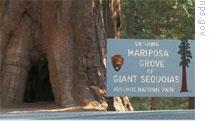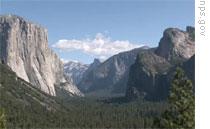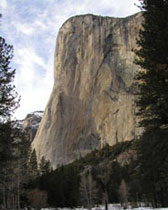VOA慢速英语 2009 017b
时间:2018-12-15 作者:英语课 分类:VOA慢速英语2009年(一)月
This is Phoebe Zimmermann.
VOICE TWO:

Half Dome 1 in Yosemite National Park
And this is Steve Ember with EXPLORATIONS in VOA Special English. Today, we tell about one of the most famous national parks in the United States. You can find it high in the Sierra Nevada Mountains of the western state of California. It is one of the most beautiful places in the country. Its name is Yosemite.
(MUSIC)
VOICE ONE:
Yosemite National Park is a place of extremes. It has high mountains. It has valleys formed by ancient ice that cut deep into the Earth millions of years ago. Water from high in the mountains falls in many places to the green valley far below. There are thirteen beautiful waterfalls in Yosemite Valley. One of these waterfalls, Yosemite Falls, is the fifth highest on Earth.
Up in the mountains are clear lakes, quick-moving small rivers, and huge formations 2 of rock. One huge rock is called Half Dome. It rises more than two thousand seven hundred meters into the air.
Yosemite has a beautiful slow-moving river and large grassy 3 areas where you can see wild animals. More than sixty kinds of animals live in the park. Deer are very common. You can see them almost everywhere. They have little fear of humans. You might even see a large black bear. You can also see two hundred different kinds of birds. In a place called the Mariposa Grove 4, visitors can see some of the largest, tallest and oldest living things on Earth. These are the giant Sequoia 5 Trees. One of these trees is called Grizzly 6 Giant. It is more than one thousand eight hundred years old. One tree is almost ninety meters tall. Another is more than ten meters around. The huge old trees can make you feel very, very small.
In a place called the Mariposa Grove 4, visitors can see some of the largest, tallest and oldest living things on Earth. These are the giant Sequoia 5 Trees. One of these trees is called Grizzly 6 Giant. It is more than one thousand eight hundred years old. One tree is almost ninety meters tall. Another is more than ten meters around. The huge old trees can make you feel very, very small.
(MUSIC)
VOICE TWO:
The story of the Sierra Nevada Mountains and the area that is Yosemite National Park begins about five hundred million years ago. The area then was at the bottom of an ancient sea.
Scientists believe strong earthquakes forced the bottom of the sea to rise above the water. After millions of years, it was pushed up into the air to form land and mountains. At the same time, hot liquid rock from deep in the Earth pushed to the surface. This liquid rock slowly cooled. This cooling liquid formed a very hard rock known as granite 7.
Many centuries of rain caused huge rivers to move violently through this area. Over time, these rivers cut deep into the new mountains. During the great Ice Age, millions of tons of ice cut and shaped the cooled granite to form giant rocks. Millions of years later these would become the giant rocks called Half Dome and El Capitan in Yosemite Park.
VOICE ONE:
Humans have lived in the area of Yosemite for more than four thousand years. The first people who lived there were hunters. Most were members of a tribe 8 of Native Americans called the Miwok. They lived in Yosemite Valley near the river.
During the extremely cold winters, these people would move to lower, warmer areas. They would return when the winter months had passed.
The first white Americans may have been hunters looking for fur animals. A famous American hunter and explorer named Joseph Walker passed through the area in the eighteen thirties. He reported about the huge rock formations and said there was no way to reach the valley below.
VOICE TWO:

Yosemite Valley
Citizens who had formed a military group were the first real modern explorers of the valley. They were at war with the local Indians and came into the valley. The white soldiers called the Indians Yosemites. The valley was named for the Indian tribe. Soon, reports of its great natural beauty were sent all the way back to Washington, D.C.
In eighteen sixty-four, a United States senator 9 called for legislation 10 to give the Yosemite Valley to the state of California as a public park. The legislation said the valley should be preserved and protected. President Abraham Lincoln signed the bill after Congress 11 approved it.
This event was extremely important in the history of the United States. It was the first time that a government had approved a law to preserve and protect land because of its great beauty. The land was to be kept for the public to enjoy. Yosemite became the first state park. It was the first real park in the world. In eighteen ninety, it became a national park. The National Park Service is responsible for the park today. It is preserved and protected for all people to enjoy.
(MUSIC)
VOICE ONE:
No major roads lead to Yosemite National Park. Visitors must leave the highways and drive their cars over smaller roads. Yosemite is about three hundred twenty kilometers east of San Francisco.
It is deep in the Sierra Nevada Mountains. The roads leading to the park pass over lower parts of the huge mountains. Then the road goes lower and lower into the area of the park called Yosemite Valley.
Visitors can stay in different kinds of places in Yosemite Park. Several beautiful old hotels have been built on the property. Some are very costly 12. Others cost less. Many people bring temporary cloth homes called tents. It costs only a few dollars a day to place a tent in the approved areas.
Visitors can walk through many areas in the beautiful valley and the mountains. These walking paths are called trails. The National Park Service has improved more than one thousand one hundred kilometers of trails. It is fun to explore these trails. Some take only a few minutes to walk. Others can take several days to complete.
VOICE TWO:

El Capitan
People come from all over the world to climb one of the huge rock formations at Yosemite. The most famous of these is called El Capitan. People who climb it call it "El Cap." Climbing El Cap is only for experts. This activity is called "hard rock climbing." It is extremely difficult and can be very dangerous.
A climber must have expert skill and great strength. The climb is straight up the face of a rock wall. Experts say it can take about three days to climb to the top of El Cap. The climbing is very slow.
Climbers must look for cracks in the rock. They place their hands and feet in the cracks and then work their way up. They also use ropes and special equipment. From the bottom of the valley to the top of El Cap is about one thousand one hundred meters.
(MUSIC)
VOICE ONE:
In the summer months, Yosemite Park is filled with visitors. Large buses bring people from San Francisco to spend the day.
They leave San Francisco very early in the morning and arrive back late at night. They drive from one place to another to see Yosemite. Other visitors come by car.
Some even come by bicycle. Some visit for just a few hours. Others take several days or weeks to enjoy the park. Many visitors come to Yosemite again and again. About four million people visit the park every year.
VOICE TWO:
In the winter, heavy snow falls in the Sierra Nevada Mountains and Yosemite. The snow usually begins to fall in the month of November. Heavy snow forces some of the roads into Yosemite to close during the winter months. The National Park Service works 13 hard to keep most of the roads open.
Drivers must use special care because of ice and snow on the roads. They enjoy a special beauty never seen by the summer visitors. Many winter visitors come to Yosemite to spend their time skiing at Badger 14 Pass. Badger ski area is the oldest in California. It has a ski school for those who want to learn the exciting sport.
Many visitors come to enjoy the park with its heavy coat of winter snow. In some areas the snow is many meters deep. Some of the tall mountains keep their snow until the last hot days of summer.
VOICE ONE:
Whenever visitors come to Yosemite, they experience great natural beauty. A visit to the park provides lasting 15 memories of what nature has produced. Most people who come to Yosemite usually bring a camera. They take many of pictures of the huge rocks, the beautiful Yosemite Valley, the waterfalls and the giant trees.
But you do not really need a photograph to remember its great natural beauty. Yosemite will leave its image in your memory forever.
(MUSIC)
VOICE TWO:
This program was written by Paul Thompson. It was produced by Mario Ritter. Our studio engineer was David Bodington. This is Steve Ember.
VOICE ONE:
And this is Phoebe Zimmermann. Join us again next week for another EXPLORATIONS program in VOA Special English.
- The dome was supported by white marble columns.圆顶由白色大理石柱支撑着。
- They formed the dome with the tree's branches.他们用树枝搭成圆屋顶。
- Clouds are formations of condensed water vapour. 云是由凝聚的水蒸气构成的。 来自《简明英汉词典》
- New word formations have not regularity. 新词的构成没有规律。 来自《简明英汉词典》
- They sat and had their lunch on a grassy hillside.他们坐在长满草的山坡上吃午饭。
- Cattle move freely across the grassy plain.牛群自由自在地走过草原。
- On top of the hill was a grove of tall trees.山顶上一片高大的树林。
- The scent of lemons filled the grove.柠檬香味充满了小树林。
- The sequoia national forest is at the southern end of the sierra nevada range.红杉国家公园位于内华达山脉南端尽头处。
- The photo shows the enormous general Sherman tree in California's sequoia national park.照片显示的是加利福尼亚州红杉国家公园内巨大的谢尔曼将军树。
- This grizzly liked people.这只灰熊却喜欢人。
- Grizzly bears are not generally social creatures.一般说来,灰熊不是社交型动物。
- They squared a block of granite.他们把一块花岗岩加工成四方形。
- The granite overlies the older rocks.花岗岩躺在磨损的岩石上面。
- This is a subject tribe.这是个受他人统治的部落。
- Many of the tribe's customs and rituals are as old as the hills.这部落的许多风俗、仪式都极其古老。
- The senator urged against the adoption of the measure.那参议员极力反对采取这项措施。
- The senator's speech hit at government spending.参议员的讲话批评了政府的开支。
- They began to draft legislation.他们开始起草法规。
- The liberals band together against the new legislation.自由党员联合一致反对新的立法。
- There were some days to wait before the Congress.大会的召开还有几天时间。
- After 18 years in Congress,he intented to return to private life.在国会供职18年后,他打算告老还乡。
- It must be very costly to keep up a house like this.维修这么一幢房子一定很昂贵。
- This dictionary is very useful,only it is a bit costly.这本词典很有用,左不过贵了些。
- We expect writers to produce more and better works.我们期望作家们写出更多更好的作品。
- The novel is regarded as one of the classic works.这篇小说被公认为是最优秀的作品之一。